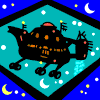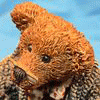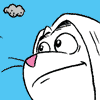
GreatGranddaughter Yaga, Xenobiologist - and her lift-ship,
Miz Yaga is seen here checking out samples of another planet's plant-life. I think her lift-ship is named "Cache".
Category Artwork (Traditional) / All
Species Feline (Other)
Size 1200 x 963px
File Size 417.3 kB
Listed in Folders
I think I used a Sakura 'brush-pen' - using the fake brush (soft spongy thick point). It is a portable approximation for a thick Japanese pointed ink brush. I keep one or two, and every so often attempt to learn how to use it. I haven't yet consistently practiced with an inked brush, (real or artificial), so I am not really skilled at it. Many cartooners say that the work & time in learning the brush can be very worthwhile. The skill is in smoothly making small variations in the pressure and angle of the brush-tip to vary the thickness of the inked line as it goes onto the paper. The route to doing this well is through practice.
Marc Shirmeister ("Schirm") http://www.furaffinity.net/gallery/schirm/ often uses brush & ink to do line work in his cartoons & art.
What I was doing in that background for the plants in the distance, was using an ink-brush technique of making shaped blots to represent masses of tree leaves & bushes in Japanese landscape painting. Applying an inked brush tip with repeats of pressure, angle, and small twists, can give a repeating pattern that can represent massed clumps of leaves in distant trees. (If you imagine how the flexible tip of a brush might put ink down on paper in a stretched 'teardrop' shape, an irregular group of these 'tree-blobs' would be an effect that could give the impression of distant individual young cedar trees covering a hillside.) Some of the historical Japanese ink artists included pages showing how to make patterns of brush-strokes to suggest scenery. These pages were published to deliberately share brush techniques. I had practiced some of these from pages by 'Hokusai'.
The idea of 'alien' trees, gave me the freedom to draw a few tapering 'brush' lines for tree trunks, and then use the 'careful-careless' blobs to represent masses of leaves, like on a variety of alien 'pine trees'.
Marc Shirmeister ("Schirm") http://www.furaffinity.net/gallery/schirm/ often uses brush & ink to do line work in his cartoons & art.
What I was doing in that background for the plants in the distance, was using an ink-brush technique of making shaped blots to represent masses of tree leaves & bushes in Japanese landscape painting. Applying an inked brush tip with repeats of pressure, angle, and small twists, can give a repeating pattern that can represent massed clumps of leaves in distant trees. (If you imagine how the flexible tip of a brush might put ink down on paper in a stretched 'teardrop' shape, an irregular group of these 'tree-blobs' would be an effect that could give the impression of distant individual young cedar trees covering a hillside.) Some of the historical Japanese ink artists included pages showing how to make patterns of brush-strokes to suggest scenery. These pages were published to deliberately share brush techniques. I had practiced some of these from pages by 'Hokusai'.
The idea of 'alien' trees, gave me the freedom to draw a few tapering 'brush' lines for tree trunks, and then use the 'careful-careless' blobs to represent masses of leaves, like on a variety of alien 'pine trees'.
You have seen the Slavic/Scandinavian/Suomi taiga cache pictures, too.
It was a revelation to see internet images of the variety that was the tiny log-cabin-style food-safe & storage boxes perched up on 4 vertical log posts put into holes in the ground. Then I saw one picture that was clearly a tiny log hut (with ridged roof) on a platform set up on two big tree-trunks, the trees sawed-off about 12-feet up. There was a 'ladder' of another log leaning up near a small wooden door on the hut on the platform. There were big notches for 'steps' in the steeply slanted log. The 2 tree-trunks had big gnarly roots instead of the chicken-toes gripping the ground. This was a model for 'Baba Yaga's magic hut on 2 chicken legs'.
I don't remember too many details about Baba Yaga other than the close variations in retellings of one of the stories. I do remember the complex motivations in the stories, and how she seemed to be an archetype that could change with a story for each village or region. Very scary, but potentially a major helper. Or everyone's 'Granny' - living in the farm's food-cache, and making mushroom soup for visitors.
It was a revelation to see internet images of the variety that was the tiny log-cabin-style food-safe & storage boxes perched up on 4 vertical log posts put into holes in the ground. Then I saw one picture that was clearly a tiny log hut (with ridged roof) on a platform set up on two big tree-trunks, the trees sawed-off about 12-feet up. There was a 'ladder' of another log leaning up near a small wooden door on the hut on the platform. There were big notches for 'steps' in the steeply slanted log. The 2 tree-trunks had big gnarly roots instead of the chicken-toes gripping the ground. This was a model for 'Baba Yaga's magic hut on 2 chicken legs'.
I don't remember too many details about Baba Yaga other than the close variations in retellings of one of the stories. I do remember the complex motivations in the stories, and how she seemed to be an archetype that could change with a story for each village or region. Very scary, but potentially a major helper. Or everyone's 'Granny' - living in the farm's food-cache, and making mushroom soup for visitors.
My first exposure to Baba Yaga's legend was in Junior High. We were studying Modest Mussorgsky's Pictures at an Exhibition (sort of a tragic tale in its own right) and the one picture taht stood out in my mind was that hut on chicken legs and the old lady who inhabited it; traveling in a flying mortar, brandishing a pestle. Music was my fourth class on a study day, so I spent the next two hours in the library (twenty years before the first rudiments of the Interwebz) studying Slavic folklore.
I still love doing research!
I still love doing research!
This one is very small for a scout-ship, and the control spaces & living space is very small & snug. There are a lot of sophisticated interior design tricks to encourage comfort in within some cozy interior rooms. It may be that there are support-ships relatively near, that have the larger interiors for 'stretching' and running around.
"You also see the symbols in the plants?"
I expect that she has background in her family lore, where she was taught to interpret the symbolic clues to healing medicines within the forms of the plants of the family's home world. If we are seeing her on another world, this image may be a view of a moment of insight: Her family instruction was based on the minds that had evolved on that home world. The symbols at her finger-tips would originally be seen & interpreted through alien eyes and minds.
I have heard that the formula of the secret syrup for Persocitome actually varies from province-to-province to reflect the tastes of the locals....
I expect that she has background in her family lore, where she was taught to interpret the symbolic clues to healing medicines within the forms of the plants of the family's home world. If we are seeing her on another world, this image may be a view of a moment of insight: Her family instruction was based on the minds that had evolved on that home world. The symbols at her finger-tips would originally be seen & interpreted through alien eyes and minds.
I have heard that the formula of the secret syrup for Persocitome actually varies from province-to-province to reflect the tastes of the locals....

 FA+
FA+














Comments